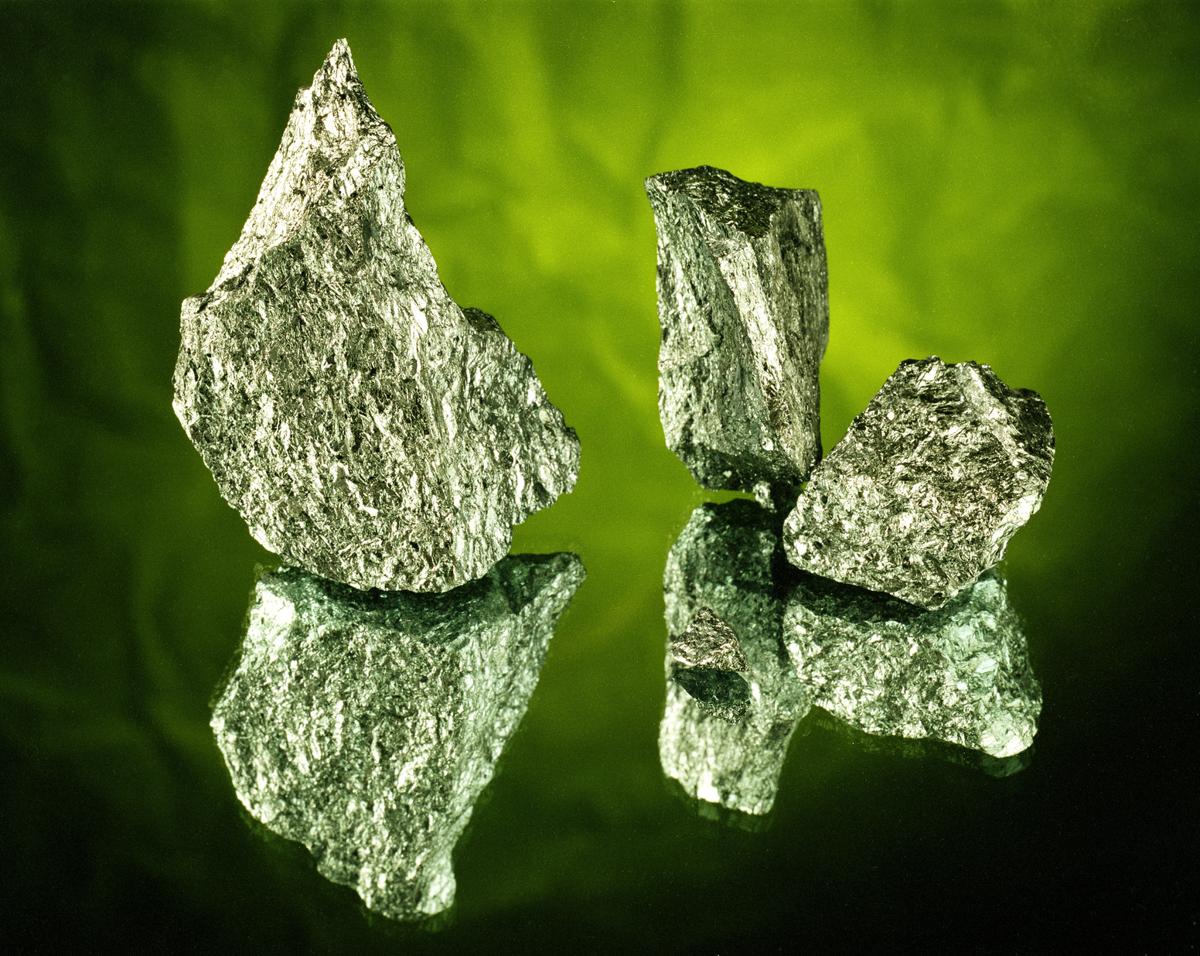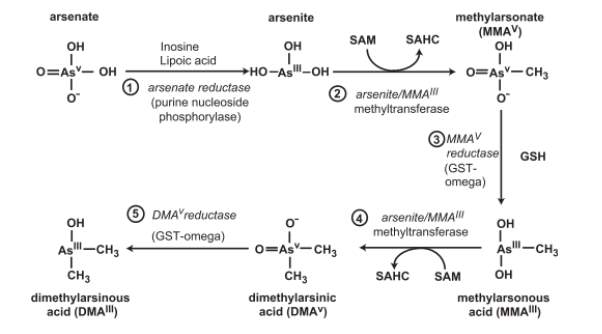
Source (1,6)
Arsenic is a chemical element with the symbol As and an atomic weight of 33. This element is classified as a metalloid with its name being derived from the latin word, arsenicium, meaning masculine. There is debate as to who discovered Arsenic, but Albert Magnus is primarily credited with its identification in 1250.
Arsenic can be found naturally in ground water, but is also released in to the atmosphere by volcanoes and mining processes. Occupational exposure is due to the manufacture of pesticides, tobacco, wood preservatives, and various other agricultural products. Arsenic exposure is usually through ingestion of food or water and effects countries all over the world.
Biotransformation (1,9)
Arsenic methylation is the primary form of bitransformation in the body. Arsenate is reduced to arsenite via arsenate reductase. Arsenite is methylated forming monomethylarsonic acid and dimethylarsinic acid (DMA5+). These two intermediates are made by arsenic methyltransferase (AS3MT) or arsenite methyltransferase. This transformation is pictured below.

Image found here
Toxicokinetics (1,4)
Clinical manifestations of arsenic exposure are characterized by Aldrich-Mees lines in the fingernails (pictured in the Signs and Symptoms section) as well as hair loss. Arsenic has a biological half-life of 10 days with 50-80% being excreted over three days. Absorbed arsenic is excreted through the urine.
- GI
- 80-90% absorption rate
- Metabolized by methylation
- Skin
- Not seen as highly as other routes of exposure
- Lungs
- Dependent on particulate size and chemical structure
Carcinogenicity (4,6)
Arsenic is a known human carcinogen which may cause cancer of the following…
- Lungs
- Kidney
- Liver
- Bladder
- Prostrate
- Skin
The IARC (International Agency for Research on Cancer) states that the strongest association of cancer is that of the lungs, bladder and skin. A study in mice that mimics the exposure level of humans to arsenic in drinking water throughout their entire lifetime has shown an increase in the development of lung cancer.
Mechanism of Action (7)
The mechanism of Arsenic is not known, but there are a couple proposed hypothesis’s
- In the pentavalent state, inorganic arsenic may replace phosphate
- In the trivalent state, inorganic/organic arsenic may react with thiols and inhibit activity
Biomarkers/Signs and symptoms of toxicity (1,2)
Arsenic has several distinct biomarkers. The presence of arsenic in hair, nails and urine are used as short-term biomarkers for acute arsenic toxicity while skin hyperpigmentation and palmoplantar hyperkeratosis are used as long-term biomarkers for chronic arsenic toxicity. Genetic polymorphisms DNA repair, oxidative stress, and serum level of carotenoids are biomarkers for susceptibility to arsenic health hazards. Arsenic toxicity can have several severe impacts whether that be short or long term.
Acute Toxicity
- Fever
- Anorexia
- Cardiac arrhythmia
- Hepatomegaly
Chronic Toxicity
- Liver injury
- Jaundice, abdominal pain and hepatomegaly
- May then lead to cirrhosis, ascites and hepatocellular carcinoma
- Peripheral Neuropathy
- Sensory and motor nerves affected
- Peripheral vascular disease
- Raynaud’s phenomenon
- Skin
- Diffuse/spotted hyperpigmentation (pictured below)
- Palmar-planter hyperkeratosis
- Skin cancer
Image found here
Genetic susceptibility or heritable traits (1,6)
- Evidence suggests that exposure at a young age can lead to a predisposition to arsenic-induced cancer as an adult
- There might be a correlation with metabolic diseases and low-moderate levels of arsenic. Study
- Arsenic may have an effect on developing fetuses
- Genetic polymorphisms have an effect on arsenic metabolism
Historical or unique exposures (3)
Arsenic has become a very substantial problem where at least 25 states have had wells containing dangerously high levels of arsenic. The USGS estimates that roughly 2.1 million people have been potentially exposed because of this. The Southwest is particularly worse due to the basin-fill aquifer’s running through volcanic and granitic rocks. Groundwater residence times, rock type, high pH, arid climate and irrigation practices are all factors that have increase the level of arsenic in these aquifers. Figure 1 is the estimated populations of private well owners with arsenic containing more than 10 micrograms per liter.

Treatments (5,6)
Acute Treatment
- Chelating agents (Dimercaprol) may help stop the absorption of arsenic as long as it is given within hours from exposure
- Intravenous fluid-fluid replacement
- Gastric lavage-prevention of further absorption
- In some cases, activated charcoal with a cathartic
Chronic Treatment
- Retinoids (vitamin A analogs) may be useful in treating arsenical keratosis
- A study using DMPS has shown promise in helping improve symptoms of chronic arsenic poisoning
- A study in Bangladesh showed that Folic acid supplements reduced blood arsenic levels by 14%
- Full recovery from chronic arsenic toxicity may take months
Essentiality (8)
Arsenic is not an essential metal due to its level of toxicity, but there are some that think otherwise. Studies in birds and mammals have indicated that complete elimination of arsenic may actually cause reproductive problems. Since arsenic is found in a lot of the foods and drinks that we consume on a daily basis it would be safe to say that the human body has grown accustomed to trace amounts of the metalloid. The question that some researchers struggle to answer is, would an elimination of all environmental arsenic actually have a negative effects on humans?
References
- Chapter 23: Toxic Effects of Metals. Toxic Effects of Metals | Casarett and Doull’s Toxicology: The Basic Science of Poisons, 8e | AccessPharmacy | McGraw-Hill Medical (ohio-state.edu)
- Chen, et. al.(2005).Biomarkers of exposure, effect, and susceptibility of arsenic-induced health hazards in Taiwan. Biomarkers of exposure, effect, and susceptibility of arsenic-induced health hazards in Taiwan – PubMed (nih.gov)
- Arsenic and Drinking Water. USGS. Arsenic and Drinking Water (usgs.gov)
- Arsenic Toxicity. ATSDR. Arsenic Toxicity: What are the Physiologic Effects of Arsenic Exposure? | Environmental Medicine | ATSDR (cdc.gov)
- How Should Patients Overexposed to Arsenic Be Treated and Managed? ATSDR. Arsenic Toxicity: How Should Patients Overexposed to Arsenic Be Treated and Managed? | Environmental Medicine | ATSDR (cdc.gov)
- Arsenic. National Institute of Environmental Sciences. Arsenic (nih.gov)
- Hughes, M (2002). Arsenic toxicity and potential mechanisms of action. Toxicology Letters. Vol. 133, Issue 1. Arsenic toxicity and potential mechanisms of action – ScienceDirect
- The Facts on Arsenic. Dartmouth Toxic Metals. The Facts on Arsenic | Dartmouth Toxic Metals
- Li, et. al. (2017). Nonsynonymous Polymorphisms in the Human AS3MT Arsenic Methylation Gene: Implications for Arsenic Toxicity. Nonsynonymous Polymorphisms in the Human AS3MT Arsenic Methylation Gene: Implications for Arsenic Toxicity – PubMed (nih.gov)